Contact us today:
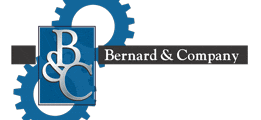
(847) 934-4500
tdaro@bernardandcompany.com

Contact us today:
(847) 934-4500
tdaro@bernardandcompany.com
Siemens Sinumerik 840D is the control of choice on turning, grinding and turn/grind models, resulting in substantial savings for its customer and EMAG
EMAG L.L.C. is the U.S. subsidiary of a major German machine tool builder who specializes in machine tools for the production of automotive, off-highway, agricultural and oil field components. The company’s equipment ranges from basic prismatic part turning centers to large workpiece, five-axis machining centers, gear hobbing machines and alternative cutting equipment such as lasers and electro-chemical machining centers. This wide variety of machine tools requires an assortment of control technologies to power and manage the motion. For one recent customer requirement, where a major agricultural equipment builder in Iowa needed grinding, turning and turn-grind machines, EMAG looked to its longtime partner Siemens for a standardized CNC solution.
CEO Peter Loetzner put it simply, “We needed to devise a control solution that would satisfy all the needs of the various machines we were supplying to this demanding customer, based on a common platform, to enable easier design, integration, start-up, commissioning on-site and training for our customer’s operations and maintenance personnel.” After reviewing the entire line of CNC offerings from various suppliers, the decision was made to use the Siemens Sinumerik 840D CNC for all of the grinding, turning and turn-grind machines to be supplied. Collaboration was a key element in the decision-making process, as Loetzner explains.
“The control we selected offered great flexibility in application, which was very important to us and our customer. They were seeking a scenario that would allow considerable cross-training of their operators, who might run a turning center one day, then a grinding or turn-grind center the next.” Loetzner further noted the control chosen offered his machine designers and the customer’s production management team an enhanced remote monitoring feature, so changes could be made on the fly with very little downtime. As a result, over 20 machines of various sizes and styles can be monitored over a wireless network, enabling process engineers to see what the operator sees on each machine.
Furthermore, owing to the global capabilities of Siemens, Loetzner commented on the control’s ability to function
in U.S., German and even Asian factories with seamless data integration. Regardless of the machine tool’s location, EMAG and its customer are able to monitor the performance of any particular machine and even report comparative production data from one continent to another. Because it sells into every industrialized nation, EMAG “…works with its customers on every aspect of a job, from the order process to tooling usage, materials handling strategies to predictive maintenance. The cultural differences are substantial sometimes and the control must be programmed to adapt to such variations. We have been most satisfied with the help Siemens has provided to us, worldwide, in this area.”
Those differences, he continued, must nonetheless be based on a common technology to streamline the integration of the CNC on the machines under construction.
Loetzner cited specifics from the project referenced in this story. “We were looking at a fairly diverse group of machines being supplied to the customer. Frankly, many of their operators were more comfortable with a CNC that is very popular in the American job shop community. However, we were able to demonstrate the immediate advantages of the Siemens control to them and they accepted our recommendations.” This value proposition, he said, hinged on the greater capability of the Sinumerik 840D to run different machine types, which translated into considerable savings on the training and commissioning side of the equation. Coupled with the remote monitoring and programming aspects of the Siemens control solution, the customer was convinced.
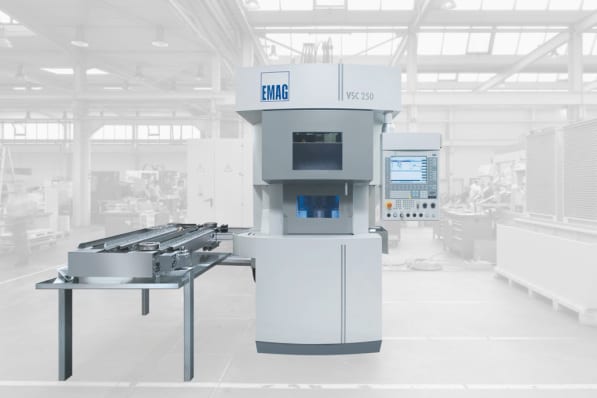
Production VSC from EMAG is a vertical pick-up turning center capable of milling, turning, grinding, drilling, even gear profiling and honing.
More than 75 percent of the EMAG machines at this particular customer are equipped with robotic devices, enabling a lights-out manufacturing scenario, another instance where the Siemens remote monitoring via Ethernet feature benefits both the machine tool builder and its customer alike. Loetzner explains, “Remote monitoring of the machine tools can be done directly through the Sinumerik CNC in a one-to-one exchange between our customer and us. Alternatively, we can communicate with Siemens and our customer in a three-way exchange of machine data and cycle information, all protected through a firewall for security and customer peace-of-mind. That’s important with all our major OEMs, of course.” Loetzner cited one customer in the agricultural machine building market, who’s used the remote monitoring capability of the Sinumerik CNC on a wide variety of EMAG machines for over three years currently, with all data communicated through a single information network, accessible by both EMAG and the control supplier. Significant reductions in downtime, service calls and troubleshooting identification time have been achieved, translating into documented savings for everyone.

Shaft machining is done on a VTC, with full 4-axis machining plus loading and unloading, all controlled by a Siemens CNC.
As a further advantage to the machine tool builder, the space reduction of more than 20 percent in the control, compared to competitive brands, meant a smaller footprint for the machine, further improving the workspace productivity of the EMAG machines for their customer. Especially in brownfield applications, where a limited space is being utilized to maximize production for an OEM, this physical space-savings combines with other advantages of the Siemens control, according to Peter Loetzner. These include reduced wiring and lower power consumption with the attendant lower operating temperatures, due to reduced ambient heat.
At this particular customer, the EMAG machines are used to produce gears, gear blanks, shafts and splines for
powertrain applications. Gear hobbing and synchronous support grinding are among the advanced machining technologies performed here. Heavy, hardened steels are the most often worked substrates.
The specific control used on these machines is the Siemens Sinumerik 840D solution line, a distributed, scalable and open control for up to 31 axes of motion, incorporating the CNC, HMI, PLC, closed loop control and communications functions into a single NC unit. Sinumerik Safety Integrated further provides a comprehensive, yet efficiently packaged suite of personnel and machine protection functions, fully compliant with internationally-accepted standards.
Commenting on the competing brands of CNC often found in job shops worldwide, Loetzner noted that the Siemens communication architecture easily accepts input from such devices, owing to its ability to capture, standardize and transmit all data in a seamless manner through its legacy tracking. “This service is another example of a forward-thinking supplier, such as Siemens, responding to brownfield conditions in the marketplace,” he noted.
EMAG machines are used by the majority of American companies for the production of such products in the Agriculture, Earthmoving, Motorcycle and Automotive and subsequent leading TIER1 suppliers. The machine builder has had a presence in the American market for over 20 years and, according to Peter Loetzner, “…we’ve received great support from Siemens, both in Germany and in the United States, for on-site service, application engineering, parts distribution, remote monitoring implementation and communications between our customers and us.”
For more information on this story, please contact:
EMAG L.L.C.
Peter Loetzner
CEO
38800 Grand River Avenue
Farmington Hills, MI 48335
Phone: 248-477-7440
Fax: 248-477-7784
Web: www.emag.com
Email: info@emag.com
OR
SIEMENS INDUSTRY, INC.
DRIVE TECHNOLOGIES
MOTION CONTROL
MACHINE TOOL BUSINESS
390 Kent Avenue
Elk Grove Village, IL 60007
Phone: 847-640-1595
Fax: 847-437-0784
Web: www.usa.siemens.com/cnc
Email: SiemensMTBUMarCom.sea@siemens.com
Attention: John Meyer, Manager, Marketing Communication
Follow us on Facebook: www.facebook.com/SiemensCNC or Twitter: www.twitter.com/siemens_cnc_us.
—
Siemens Industry Sector is the world’s leading supplier of innovative and environmentally friendly products, solutions and services for industrial customers. With end-to-end automation technology and industrial software, solid vertical-market expertise, and technology-based services, the sector enhances its customers’ productivity, efficiency and flexibility. With a global workforce of more than 100,000 employees, the Industry Sector comprises the Industry Automation, Drive Technologies and Customer Services Divisions as well as the Metals Technologies Business Unit. For more information, visit http://www.usa.siemens.com/industry.
The Siemens Drive Technologies Division is the world’s leading supplier of products, systems, applications, solutions and services for the entire drive train, with electrical and mechanical components. Drive Technologies serves all vertical markets in the production and process industries as well as the infrastructure/energy segment. With its products and solutions, the division enables its customers to achieve productivity, energy efficiency and reliability. For more information, visit http://www.usa.siemens.com/drivetechnologies.
Continue reading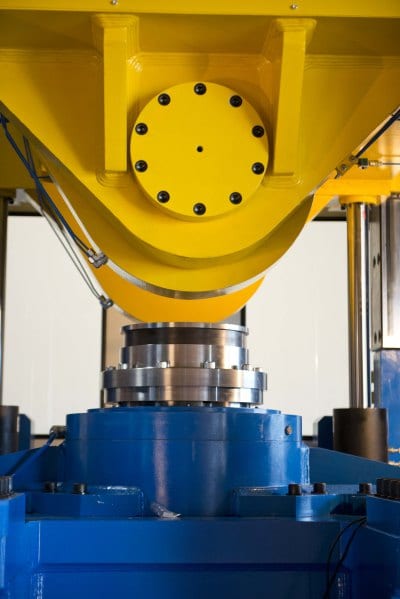
Mark Cunningham operates a Gleason gear shaper with Siemens CNC onboard. “It’s very user friendly,” he says.
Using CNC technology on advanced machine tools helps company sell its products worldwide
Roscoe, Illinois is home to many more gear companies than your average town of 10,000 people, but the reason is obvious. During the peak of the machine tool boom in nearby Rockford, it was critical to have these important components made locally. Over the years, that market has changed and so have the gear companies here, each taking its expertise in other directions to offset the decline in local machine tool building.
Forest City Gear Inc. took a different track to remain competitive globally. As Fred Young, CEO of the company, which was founded in 1955 explains, “We decided long ago to do two things. First, to make the very best fine and medium coarse pitch gears in the world, and to do so by using the best machines, people and quality assessment practices possible. Second and just as important, we became committed to reinvesting our company’s profits in newer and better machinery, based on the global standards and the ongoing technical advancements made by machine tool builders around the world.”
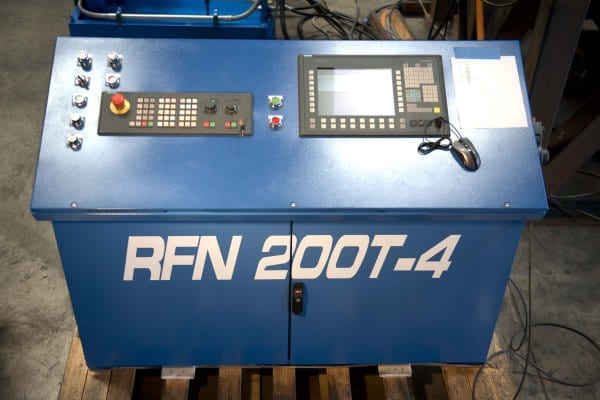
Kevin Chatfield has worked on CNC machines for 20 years. Here, he uses a Samputensili gear grinder for internal, external and form grinding. “No other CNC can do all the work the Siemens does.”
This precision gear and spline maker performs nearly every aspect of production in-house, including blanking, turning, hobbing, shaping, milling, gear grinding with form wheels and generating grinding, thread grinding, broaching, honing, straightening, laser marking, magnetic particle inspection, metal-etching, CMM, hardness testing and final surface inspection. Forest City Gear continues to subcontract heat treating and plating. The blanking department, though relatively new, has been expanded several times to keep pace with increasing production. The company boasts nearly every leading brand of gearmaking machine tool on the world market, because, as Young puts it, “We really do put our money where our mouth is, to use that old expression. In a typical year, we invest between 25 and 40 percent of our gross sales back into better gear machines and metrology.”
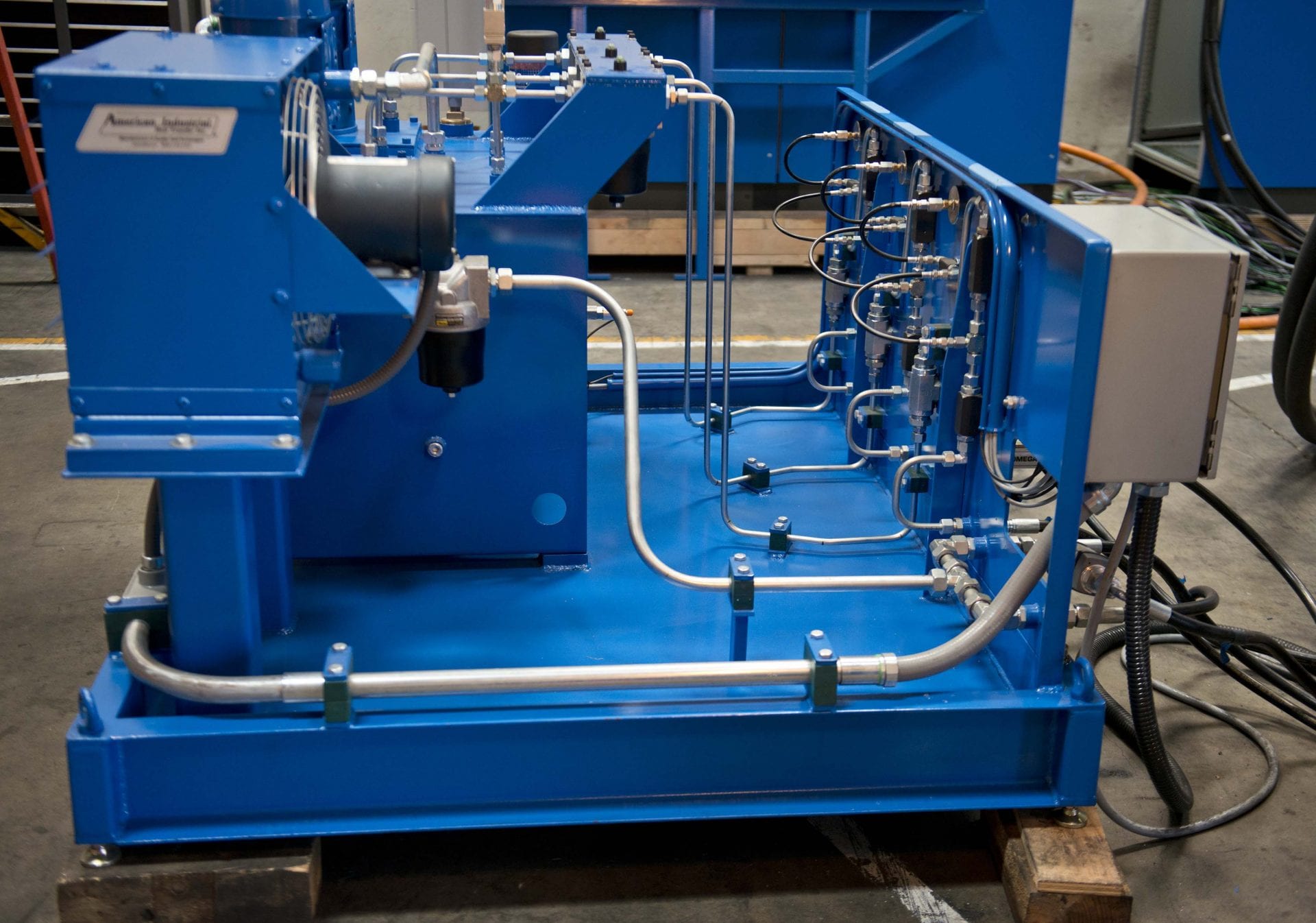
Brian Turnbull runs various machine tools, including a Hoefler gear grinder, and notes, “The CNC is easy-to-use, very easy to layout and gives me no problems navigating.”
Among the most advanced gearmaking machines in this shop are four Gleason shapers, two Samputensili grinders (form and generating style) plus a Hoefler gear grinder. All these machines have something in common.
At the heart of any machine tool, of course, is the CNC that drives it, controls the motion, detects and integrates all the cutting parameters, feeding back that information to the computer logic of the control to ensure the part being made is as close as possible to the programmed specifications. Meanwhile, the ergonomic or operator-to-machine interaction must always be considered, because a control that’s too difficult to learn and use will result in substantial and costly delays in production. While Forest City Gear has the classic mix of longtime and newer employees, who all bring a variety of computer knowledge and machining skills to the job, this company has consistently sought the most advanced equipment on the market, as part of its “Excellence Without Exception” motto and its practical desire to stay ahead of the competition in the global gear market.
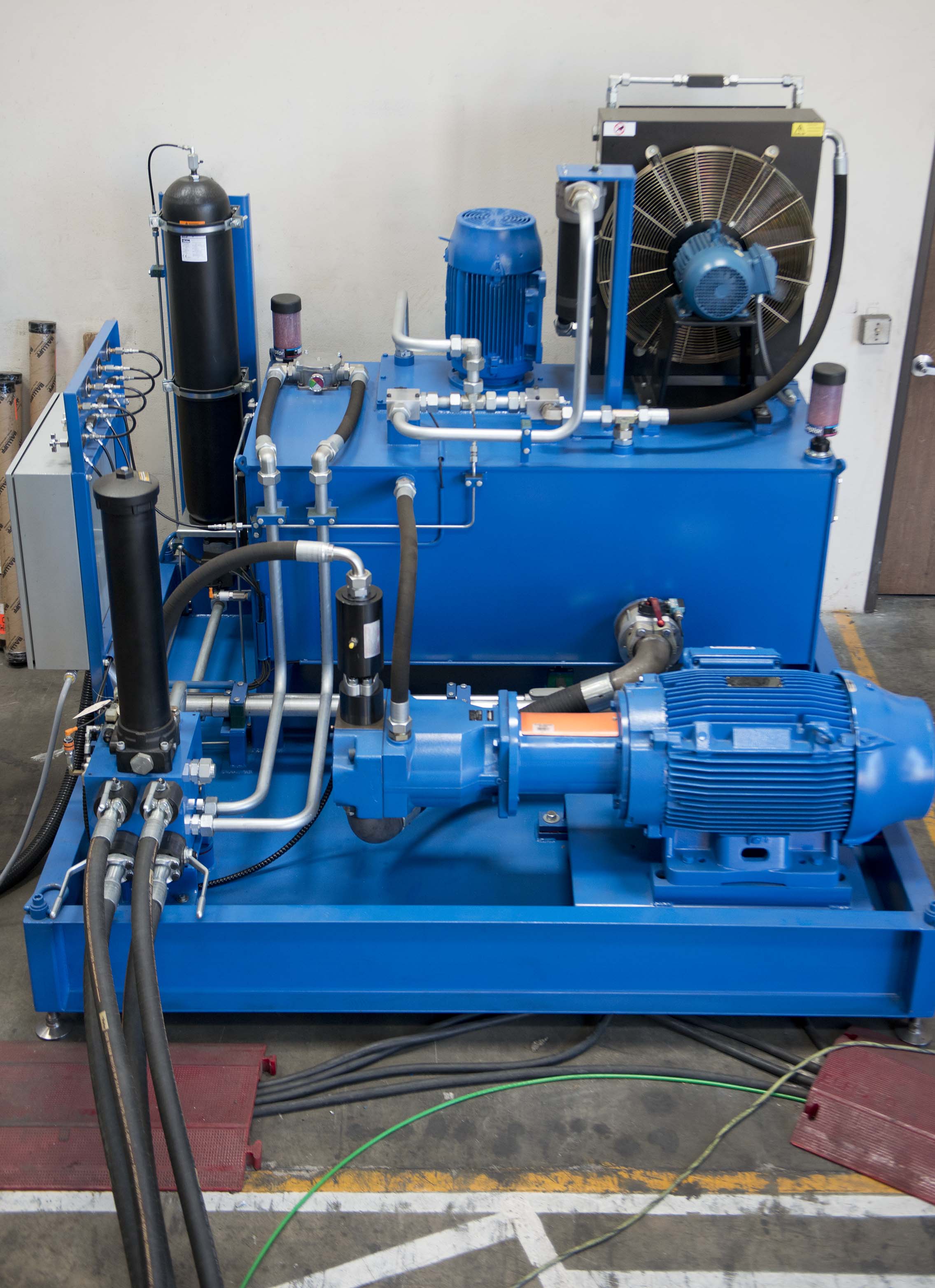
Forest City Gear is among the world leaders in fine and medium pitch gears, selling high-precision applications in medical, aerospace, defense, avionics, instrumentation and performance racing markets.
The control on these machines at Forest City Gear is the Sinumerik 840D from Siemens with specialized gear software. As Young explains, “The extensive gear software developments available are quite remarkable. Most have been a cooperative venture between a machine builder, the CNC builder and folks like us. The result has been software that’s specific to hobbing, shaping, gear grinding and thread grinding.” He also notes features of the Siemens CNC that have yielded positive impacts on the production at Forest City Gear, including “…sophisticated executive software for all machine movements and the fast program reading that allow us to cut and grind much faster, with more options such as reverse direction, segment cutting and combined operations, when compared to other controls we see.”

Company CEO Fred Young notes, “Most of the best gearmaking machines in the world use Siemens CNC and I’ve seen a lot of them, in my time.” He adds the controls have great flexibility, more motion precision and greater diagnostic capabilities than competitive brands he’s used at his company.
Typically, the CNC is used for all axis, rotary and spindle movements and the machine operators particularly appreciate the multiple standard cycles for cutting with degressive feeds, increasing speeds plus special cycles for gear tooth removal and reversing directions to improve finish or reduce cutter wear.
Forest City Gear cuts a wide variety of standard and exotic materials in the production of its gears and splines. These include titanium, Inconel, 4340, 300M, Vascomax 250 and 300, Nitralloy 135M, 9310, 4150, 4140, 8620, aluminum bronze, 13-8, 15-5, 17-4, 316 and 440 stainless, Hastelloy, Ferrium and numerous thermoplastics. The shop can carbide rehob to 60-62 RC and gear grind at all hardnesses.
Kevin Chatfield, a longtime Forest City Gear employee with 20 years’ CNC machine experience, works with the Samputensili grinders and says, “I’ve used all the brands of controls we have here… and for many jobs, no other control can do what the Siemens 840D can do. One example would be the internal, external and form-grinding I do on the Samputensili machine. If the other controls could perform these operations at all, which is doubtful, it would be a very slow process.”
Mark Cunningham, a 12-year veteran of CNC, runs the Gleason machines and notes the controls are very user-friendly. “The screens are easy-to-program and modify, then you get a clear picture of what’s happening at every step in the cycle. The precision is so good, we sometimes need to ‘lie” to the program to get what we want from the machine.”
Brian Turnbull, a newcomer to Forest City Gear, but a longtime machinist, had worked with a competing brand to Siemens CNC and was initially hesitant. “Then, as soon as I saw the easy layout, plus how quickly it could be set-up and go into action, with no trouble navigating at all, I was convinced Siemens was simply a better control.”
Young notes one last point about the CNCs on these machines. “These machine tools produce our most complex parts, including helical splines and internal gears most other shops simply cannot or will not make. The cycle and program read times on the Siemens controls are critical to our production work, plus these are the most expensive machines in the shop, so their run-time cost is the highest.” He adds, “Most of our jobs, though not all, here are short runs on very expensive materials. If the machine takes too long to complete the first part or has repeat rejects, we lose money — it’s that simple. I’m proud to say that neither our operators nor our production supervisors allow that to happen. And the controls on the machines are a big reason why we stay so successful in achieving that accuracy and consistently good part production at Forest City Gear.”
The company has remained among the leaders in the market for high-precision gears, owing to this strategy of buying the best machines, hiring the best gearmakers available and verifying the output of this 100-person shop by using the power of the industry’s leading quality lab, which occupies a cleanroom-level environment in the middle of the factory. As Young explains, “We do checking of our gears and splines at various test stations located throughout the shop, but the final proof resides in our quality lab. Our equipment is so sophisticated, even our competitors often bring us their work to have it checked. It’s one of the things that’s led to our current customer base of about 400 companies, about twenty percent of whom are other gear companies or gear producers themselves.”
For more information on this story, please contact:
FOREST CITY GEAR CO., INC.
Fred Young
CEO
11715 Main Street Roscoe, IL 61073
Toll-Free: 866-623-2168
Phone: 815-623-2168
Fax: 815-623-6620
Web: www.forestcitygear.com
Email: sales@forestcitygear.com
OR
SIEMENS INDUSTRY, INC.
DRIVE TECHNOLOGIES
MOTION CONTROL
MACHINE TOOL BUSINESS
390 Kent Avenue
Elk Grove Village, IL 60007
Phone: 847-640-1595
Fax: 847-437-0784
Web: www.usa.siemens.com/cnc
Email: SiemensMTBUMarCom.sea@siemens.com
Attention: John Meyer, Manager, Marketing Communication
Follow us on Facebook: www.facebook.com/SiemensCNC or Twitter: www.twitter.com/siemens_cnc_us.
—
Siemens Industry Sector is the world’s leading supplier of innovative and environmentally friendly products, solutions and services for industrial customers. With end-to-end automation technology and industrial software, solid vertical-market expertise, and technology-based services, the sector enhances its customers’ productivity, efficiency and flexibility. With a global workforce of more than 100,000 employees, the Industry Sector comprises the Industry Automation, Drive Technologies and Customer Services Divisions as well as the Metals Technologies Business Unit. For more information, visit http://www.usa.siemens.com/industry.
The Siemens Drive Technologies Division is the world’s leading supplier of products, systems, applications, solutions and services for the entire drive train, with electrical and mechanical components. Drive Technologies serves all vertical markets in the production and process industries as well as the infrastructure/energy segment. With its products and solutions, the division enables its customers to achieve productivity, energy efficiency and reliability. For more information, visit http://www.usa.siemens.com/drivetechnologies.
Continue reading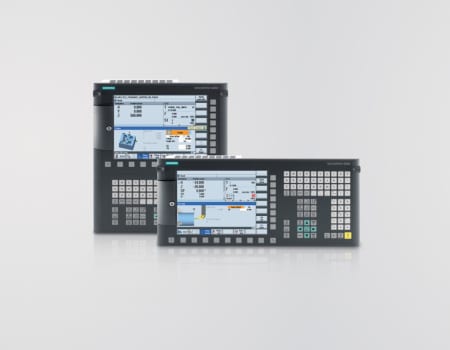
For machine tool end-users and OEMs, Siemens will exhibit new value-added services ranging from condition monitoring and manufacturing IT to innovative solutions for CNC training and machine tool retrofit, as well as the newest innovations in CNC (computer numerical control), motor and drive technology.
SOLUTIONS FOR MANUFACTURING EXCELLENCE
Condition Monitoring and Manufacturing IT are two value-added services that are continuing their introduction to the U.S. machine tool market.
Condition Monitoring is an internet-based service from Siemens that supports maintenance processes while simultaneously forming a platform for cross-company service and support between OEMs and machine operators. Services can be configured over secure Internet connections from anywhere in the world via a standard PC, an internet connection and a web browser.
Manufacturing IT solutions from Siemens provide software tools for fast, easy integration of machines in a production network, while ensuring that production planning, scheduling and execution
is always problem-free and based on the very latest data.
An entire line of powerful software modules for production machines ensures optimum integration of the machines in the IT-environment and supports a wide range of different functionalities including:
For the aerospace market, the new Sinumerik 840D solution line is the latest in CNC technology that increases performance and user productivity. The Sinumerik 840D sl is a universal and flexible CNC system featuring the innovative Sinamics S120 drives that can be used for up to 31 axes. It is a distributed, scalable, open and inter-connecting system offering a wide range of specialized functions for milling, drilling, turning, grinding and handling technologies.
The Sinumerik 840D offers users innovative features that increase productivity on the manufacturing floor, especially the challenging segments of high-speed and five-axis aerospace machining.
SOLUTIONS FOR THE JOB SHOP
For the job shop, the new Sinumerik 828D numerical control will be presented. Perfect for
mid-range machine tools, the Sinumerik 828D is designed to address the needs of complex milling and turning machines in the job shop segment. It combines CNC, PLC, operator panel and axis control for six CNC measurement circuits in a single, robust operator panel.
The Sinumerik 828D is capable of full graphical, high-level language command and supports ISO programming that is customary in the United States. Programming time can be further reduced for small-batch production with the use of the ShopMill and ShopTurn graphical workstep programming system, while high-level language programming can be used in conjunction with programGuide to significantly reduce programming times for large-scale serial production.
With the introduction of the Sinumerik 828D, modern PC and mobile phone technology is now available to the mid-range machine tool. Extensive online help animations and a new type of input prompting system with moving picture sequences provide the basis for exceptional user convenience. USB, Compact Flash (CF) card and Ethernet ports enable high-speed data transfers onto storage media or integration of the control system into corporate networks. Through the use of its Easy Message functionality, the Sinumerik 828D offers production status monitoring by text messaging (SMS). Depending on the recipient’s profile setting, the machine will transmit information about workpiece machining status, report on the tool condition currently in use and send machine maintenance bulletins to a mobile phone, anytime and anywhere. These combined functions are designed to help keep machine downtime to a minimum.
Newly introduced to the American machine tool industry, and based upon the new Sinumerik Operate user interface, SinuTrain is the ideal solution for control-identical CNC training.
With SinuTrain, actual NC programs are developed and simulated, to speed the program generation protocol. In this way, machine tool operators not only learn the control language commands, but they also visualize part programs on a PC screen that are identical to the machine tool’s screen. As a further benefit, programs generated through SinuTrain can then be used on actual machines.
SinuTrain is available for different needs and budgets including a trial version, a study version, a single-user license and an educational license. It is available in English, Spanish, French, German, Italian and Simplified Chinese, and requires Windows® XP (32-bit). Support for Windows 7 (32- / 64-bit) coming in 2011.
For more information about CNC solutions and services from Siemens, point your web browser to www.usa.siemens.com/cnc.
For specific product information and inquiries:
SIEMENS INDUSTRY, INC.
DRIVE TECHNOLOGIES
MOTION CONTROL
MACHINE TOOL BUSINESS
390 Kent Avenue
Elk Grove Village, IL 60007
Phone: 847-640-1595
Fax: 847-437-0784
Web: www.usa.siemens.com/cnc
Email: SiemensMTBUMarCom.sea@siemens.com
Attention: John Meyer, Manager, Marketing Communication
Follow us on Facebook: www.facebook.com/SiemensCNC or Twitter: www.twitter.com/siemens_cnc_us.
—
Siemens Industry Sector is the world’s leading supplier of innovative and environmentally friendly products, solutions and services for industrial customers. With end-to-end automation technology and industrial software, solid vertical-market expertise, and technology-based services, the sector enhances its customers’ productivity, efficiency and flexibility. With a global workforce of more than 100,000 employees, the Industry Sector comprises the Industry Automation, Drive Technologies and Customer Services Divisions as well as the Metals Technologies Business Unit. For more information, visit http://www.usa.siemens.com/industry.
The Siemens Drive Technologies Division is the world’s leading supplier of products, systems, applications, solutions and services for the entire drive train, with electrical and mechanical components. Drive Technologies serves all vertical markets in the production and process industries as well as the infrastructure/energy segment. With its products and solutions, the division enables its customers to achieve productivity, energy efficiency and reliability. For more information, visit http://www.usa.siemens.com/drivetechnologies.
Continue readingInternational firm uses robotic ultrasonics and conventional machine tools to supply product, usually with 24-hour turnaround; achieving near 24-7 unattended operation with over 15 percent reduction in scrap material on very expensive substrates.

We interviewed Tim McKimson, Core3D’s Worldwide Director of Engineering, at OpenHealth’s Las Vegas-based Core3D facility, located near the prestigious Las Vegas Institute for Advanced Dental Studies (LVI), where restorative and cosmetic dental techniques are taught to practicing dentists and lab technicians, Here, Core3D provides a full range of CAD/CAM/CNC machining and finishing services to LVI and dental labs across the United States. Led by technical operators Mark Ferguson, Danny Palomares and Drew Hrubes, the Core3D team prepares CAD files developed from data typically gathered with an iTero oral scanning wand or from CAD files from scans of conventional dental impressions from the patient’s mouth, which are then digitally captured in a dental scanner from companies such as 3shape. CADENT and other software are typically used to image the impression and begin the process of creating the crown, bridge, abutment, coping, implant or even full denture restoration, as required by the individual lab. 3D CADENT files are G-coded at a remote location of the parent company for transfer to the CNC machine tools at the various Core3D facilities worldwide.
The next step is translation of the digital impression to a RenShape® mold, using conventional machine tools. In most cases, the required structures are designed simultaneously, then the mold with coping is introduced to the DMG Sauer ultrasonic dental machine for preparation of the final structures. This is where the most advanced substrates are processed, ranging from conventional, yet difficult to machine metals such as titanium and cobalt chrome, to the newest advanced materials, including glass ceramics, lithium disilicate and zirconia. These substrates are quite expensive, therefore extreme care is taken in their handling and processing to reduce scrap and conserve operating costs.
As McKimson explained, the decision to cut with ultrasonic technology was relatively easy, given the inherent wear conditions and high cost of conventional tooling. In the ultrasonic process, a combination of electrolysis and fluid lubrication act in concert to create an ionic attraction of particles, removing material in a highly predictable and accurate manner, without the mechanical stress implicit in conventional machining techniques. As a result, the surface of even the hardest materials can be machined with the necessary tactile smoothness required for dental implants.
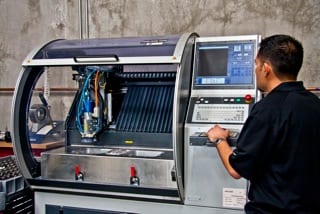
The extremely hard materials being machined are produced with accuracies in the 2-4 micron range, owing to the combination of ultrasonic technology and the high precision of the Sinumerik CNC, according to McKimson, who notes the reliability of this accuracy has been a significant advantage in reducing scrap at Core3D.
In another area of the facility, conventional mills are used to make polyurethane models and Wieland Zeno 4820 and 4030 mini-milling machines are also utilized for the production of various crowns, wax/resin forms and models, veneers, inlays and implant abutments.
As evidence of the decidedly international nature of this emerging dental giant, all the zirconia and lithium disilicate materials are provided in the IPS e.max System from Ivoclar Vivadent, a company based in Liechtenstein. The company has branches in the United States and Canada, which supply the Core3D Centres in those countries. The templates and cutting tools are closely controlled and validated by the manufacturer to ensure that the preparation of these materials in dental applications is properly executed.
In commenting on the use of the DMG Sauer ultrasonic machines, McKimson notes that it was the machine builder who recommended the Siemens control. “They knew we were dental technicians and engineers, not machinists, by nature. The Siemens control has been extremely easy-to-use and our training time from the builder was minimal. Troubleshooting is mostly done by our operators, with only occasional assistance from Siemens.” Danny Palomares, one of the technical operators, agrees. “My training is in the dental lab world, not on machine tools. It was a great relief to have such a sophisticated control operate with relatively simple language commands and cycle adjustments.”
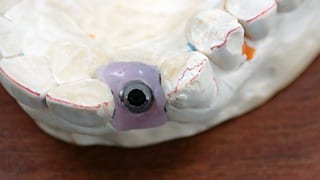
While there are substantial differences between the European and American dental labs in terms of the materials and assembly techniques used, and despite the fact that literally all projects are highly customized based on the individual needs of the patients and the preferences of the labs and those of the dentists performing the procedures, in the end, the typical project is being turned in 24 hours or less.
For Core 3d Centres, utilizing the best-in-class equipment is critical. In complement the quality machines here, a key part of the overall efficiency protocol in the Core3D network of companies, McKimson points out, is the “know-how” provided through their CAM-DO committee. This global technical committee conducts regular online meetings to discuss what’s working and what’s not in their various worldwide operations and then optimizes and standardizes the processes. He recalls one unanimous vote of approval was voiced on the performance of the DMG Sauer ultrasonic machines with Siemens controls. Core3D currently has nine such machines in their network, all used to process the most advanced materials.
® RenShape is a registered trademark of Huntsman Corporation.
For more information on this story, please contact:
Core3D Centres
Tim McKimson
Engineering Technology Director
5955-2 Wigwam Avenue
Las Vegas, NV 89139
Toll-Free: 1-888-750-9204
Phone: 702-750-9204
http://www.core3dcenters.com/
tmckimson@core3dcenters.com
OR
Siemens Industry, Inc.
John Meyer
Manager, Marketing Communications
390 Kent Avenue
Elk Grove Village, IL 60007
(800) 879-8079 ext. Marketing Communications
www.usa.siemens.com/cnc
SiemensMTBUMarCom.industry@siemens.com
Follow us on Facebook: www.facebook.com/SiemensCNC or Twitter: www.twitter.com/siemens_cnc_us.
—
Siemens Industry Sector is the world’s leading supplier of innovative and environmentally friendly products, solutions and services for industrial customers. With end-to-end automation technology and industrial software, solid vertical-market expertise, and technology-based services, the sector enhances its customers’ productivity, efficiency and flexibility. With a global workforce of more than 100,000 employees, the Industry Sector comprises the Industry Automation, Drive Technologies and Customer Services Divisions as well as the Metals Technologies Business Unit. For more information, visit http://www.usa.siemens.com/industry.
The Siemens Drive Technologies Division is the world’s leading supplier of products, systems, applications, solutions and services for the entire drive train, with electrical and mechanical components. Drive Technologies serves all vertical markets in the production and process industries as well as the infrastructure/energy segment. With its products and solutions, the division enables its customers to achieve productivity, energy efficiency and reliability. For more information, visit http://www.usa.siemens.com/drivetechnologies.
Continue readingGM realizes “weeks to hours” reduction in line change and transmission build dynamics at Toledo Powertrain, resulting from Flexible Assembly Configuration System (FACS) and Siemens control/communication
A tried and true euphemism nowadays, “thinking outside of the box” usually refers to a pattern of thought or action that results in rapid innovation, enhanced relationships being developed from established concepts as well as new ones, plus a genuine willingness to forego past practices in favor of a better way. Enter the GF6 six-speed, front wheel transmission line at General Motors Powertrain on Alexis Road in Toledo, Ohio.
Here, a new front wheel drive transmission line for smaller, more fuel efficient vehicles such as the popular Chevy Malibu and new Chevy Cruze is currently ramping up to its initial goal of 2200 units per day. Nothing new about such an event, until a closer look reveals the method used to program this line, implement changeover, stage the workpiece flow, perform all machining, secondary operations and assemble the finished transmissions.

Greg Nazareth, GM controls engineer, demonstrates the reconfiguration procedure on the FACS server, part of the overall Flexible Assembly Configuration System, provided by Elite Engineering of Rochester Hills, Michigan.
During the development of this line, several years ago, GM engineering contacted its longtime controls suppliers to investigate ways of significantly reducing the workflow through the line, as well as enable faster changeover, reduce reprogramming and prevent the curse of all automated manufacturing lines, situations where one out-of-spec machine caused complete shutdown. Another key driver in the development of the GF6 line was the need to minimize maintenance time by installing PLCs, drives and component pallet recognition devices outside the conventional cabinetry found on traditional assembly lines. In addition, controllers were distributed throughout the system, which allowed for removal of typical zone controllers and, in turn, substantially increased system flexibility.
Following considerable investigation into the process for the new line, the major obstacle remained changeover and the need for a more flexible yet highly automated system of transmission builds. In consultation with the controls provider on the existing six-speed, rear wheel drive line, Siemens Automotive Center of Competence (Troy, Michigan), as well as third party software package provider, Elite Engineering (Rochester Hills, Michigan), a deterministic study was undertaken and the result was the line now in production. Siemens provided the PLC, CNC, HMI, RFID and its high-level Ethernet protocol, Profinet, to run on the GM network. Overlaying this hardware and communications topology, Elite Engineering delivered its Flexible Assembly Configuration System (FACS), complemented by Siemens to create its SIFACS solution, wherein all the control elements for every assembly operation and test stations would be fully integrated. SIFACS largely focuses on the integration of the core PLC software blocks and functionalities of the individual stations with the RFID tags on each of the workpiece pallets, according Jim Remski, manager of powertrain activities for Siemens.

Siemens CNC and HMI technology combine with its Profinet high-level Ethernet communications and RFID pallet tags to execute the machining, assembly and testing at this transmission plant, currently targeting an output of 2200 units/day.
AN INTEGRATED APPROACH
Within any flexible automated assembly system, the keyword is flexible. All hardware and related software must be designed with a deterministic functionality that is both valuable to the customer’s build strategy and cost-competitive, as well. Working with technical specialists in safety integrated systems and industrial communications alike was the key to the success of this project at GM Toledo. By creating a decentralized control network that was nonetheless in complete harmony with the overall workflow of the plant, GM and Siemens devised the optimum modular yet flexible architecture for the entire system. This totally integrated automation approach not only addressed multiple families of hardware involved, it also coordinates all code development, safety and communications functions into a seamless and interdependent yet highly flexible and adaptive control scheme.
This integration is nowhere more visible than in the modular and open controller and I/O rack assemblies located throughout the facility. A Siemens Simatic® S7 CPU, the Siemens Safety Integrated drives platform and all I/O, including RF antennas for RFID tag reading are configured and reside here.
Diagnostics in the system are similarly integrated, according to Matthew Thornton and Jeremy Bryant, who consulted from Siemens. “We devised pre-made templates and blocks important to the powertrain build process, as our starting point,” commented Thornton, who further noted the importance of placing the critical performance data on all the HMI panels in the system for easy operator access. “With all motion and safety functions integrated into the drives, there was no need to build a separate troubleshooting architecture for what would be a more traditional safety network of relay cabinetry.”
Bryant continued, “Only a few components talk on the Profibus system, all other I/O and automation components communicate over Profinet.
Reinhold Niesing of the Siemens Automotive Center of Competence further explained the contact process between his group and the provider of the FACS. “They provided the configuration and monitoring system, while we (Siemens) provided the automation run time system. Both systems needed to run in sync to provide GM with configurable options, when changes in production or manufacturing enhancements were needed.”

Each RFID tag carries all the information needed to produce the part at each of the machining and assembly stations in the line.
The result of this collaboration, coordinated under the Siemens Transline solution, whereby all operational, visualization and diagnostic functions are streamlined in a consistent control scheme, was the Transline HMI Lite CE package. This package provides uniform user interface for operational and diagnostic functions on the vast majority of the various machine tools, transfer lines, robotics, assembly machines, sensing devices and vision systems throughout the entire facility. As Michael Grass, project manager for Siemens, explains, “The best part is that the package can be customized to meet specific user needs and preferences. It provides our SIFACS (see sidebar) system of configurable assembly automation very useful information, as the two systems complement each other quite well.” In the safety communications area, he also noted that GM is currently reviewing another Siemens option for open safety communications technology on distributed automation systems.
RFID GETS THINGS STARTED
As a workpiece proceeds through the line, having been delivered by an AGV in most cases, each pallet is equipped with an RFID tag. Reinhold Niesing, engineering manager on the project for Siemens, explains, “The key here is the data throughput in the system, as it directly impacts the cycle time or takt time (maximum allowable time to produce one finished part or product) of the line. The tags must be able to function in static mode, whereby the data on the part must be read before the process begins. Model number, serial number and build status information are all contained in the tag. The faster we read the information, the faster the process begins.” Niesing also detailed the dynamic mode of operation for this RFID system, in which the information at subsequent line stations must be read “on the fly” without any line stoppage, as is often seen in conventional packaging, shipping or other line applications for RFID. In this case, all data are read as the tag passes by the antenna.
Often, in less sophisticated applications, the signal can degrade over time and number of reads. Here, according to the Siemens technical specialists, two interface protocols are supported, namely, ISO 15693 (open standard) and a proprietary Siemens-developed standard, Simatic RF300. The latter uses a state-of-the-art chip paired with highly optimized communications to achieve the faster data read/write rates. Large amounts of data (64kB) are handled in faster cycle times, while the overall RFID solution is applied in a high-speed, non-stop environment. One of the key drivers in the system is the fact that each RFID tag has both EEPROM and FRAM. The 20-byte EEPROM is actually designed to be a one-time programmable memory chip (OTP), a security feature that was deemed most desirable by GM for this application. Meanwhile, the FRAM can be written and rewritten many times for optimum utilization of the hardware, over time.
Despite this level of sophistication in the RFID hardware, the system easily communicates over the existing Profinet, Profibus and other common protocols.
LOGIC BLOCKS ALL AROUND
The overall thrust of the line development, according to George Jewell, the GM engineer responsible for the implementation of the FACS online at the Toledo plant, was to have consistent, even identical logic blocks at every station. This would allow, as is seminal to the FACS architecture, immediate successive modifications to be made in the machine or assembly operations performed, throughout all stages of the line. When rebalancing was needed, when an upturn/downturn in current production was required or when an entirely new model came onto the line, the changeover needed to happen in hours, rather than in weeks, as was the industry norm.
By standardizing on the hardware, software and communication protocols used, engineering costs could be contained and, as a collateral but vital side effect, maintenance on the system could be made much more efficient with much of the system hardware exposed on the line, rather than enclosed in electrical cabinets, again the norm for the industry in the past. Flexible modules would allow more rapid reconfiguration, product changes and a genuine synergy with the ongoing GM commitment to continuous improvement in the line, as the new GF6 transmission ramped up to incremental target levels of production.
Jewell noted that Siemens responded to the challenges, “…with a plug-and-play technology approach, coupled with an understanding of the processes we utilize.”
From the utility perspective, he also noted that the run-time component in the system would function without the full configuration system being online, further complementing a decentralized architecture. Bob Raven, GM controls manager, further commented, “The Siemens commitment to provide this value added functionality geared towards flexibility within our manufacturing principles has substantially supported GM Powertrain’s efforts to standardize processes, controls and continuously improve.”
Currently, GM uses the FACS at various plants in Mexico, China, India, Thailand, Korea and the U.S. — and soon in Canada and Eastern Europe, for the production of transmissions, engines and even the generator on the new Chevy Volt. These products, it should be noted, can be manufactured, assembled and tested, all within the same flexible control architecture, while supporting standardized GM processes.
Rather than textbook product life cycle management, Jewell sees FACS as more of a production line life cycle management tool, as its inherent adaptability means common hardware can be made to do diverse tasks, at varying rates, with on-the-fly changeover, in far less time than previously possible.
TYPICAL STATION DYNAMICS
On one automated assembly station, Hanwha produces the various sub-assemblies of the transmission, as other lines produce the components that go into the sub-assemblies. Adding a station, as Greg Nazareth, GM controls engineer, explained, requires simply adding a PLC with the standard SIFACS logic, desired process devices and downloading an eFACS configuration. In contrast to the traditional zone control, this reconfiguration is not a building block concept; rather, the instructions being given impact the entire line. Nazareth worked with the full GM controls team, headed by Ron Goeckerman, to implement FACS with the host server.
By contrast, all manual workstations on this line have the same download received to a PLC, provided by Siemens in its Simatic lines. While not reliant on the server network in a deterministic mode, the manual stations nonetheless utilize the same software to execute quick tooling changes, machine sequence variations, line balancing and report tracking. Operators received training from both Siemens and Elite Engineering personnel for these tasks.
All part build histories, troubleshooting and machine debugging are recorded for further analysis.
CONTROLS CALL THE BALL AT EVERY STEP
Throughout the metalcutting process here, mostly in the gear and spline forming, hobbing, grinding and finishing, CNC technology is onboard dozens of machine tools. Most of the machines here are controlled by Sinumerik® 840D, the highest-level CNC offered by Siemens. The control not only processes the particular part dimensions in the cutting theater of the machine, it also coordinates all motion control and movements into and out of the machine. Working in tandem with the other hardware and communication network software in the line, for example, ring gears cut on a Wera Profilator machine are indexed from one station to the next, in timed sequences, to coordinate with predetermined production requirements. This operation occurs in a fully automated mode, requiring no operator intervention, except for maintenance and planned inspections.
Likewise, in the machining of valve bodies and transmission cases, each step of the process is controlled by the Siemens CNC to produce the required components in the proper sequence for subsequent assembly and testing operations. During those subsequent operations, other motion control devices and software solutions provided by Siemens execute, monitor and control the assembly process, through the SIFACS solution set. (See sidebar.)
PROFINET TALKS THE TALK
Through a decentralized and cabinet-less design, GM achieves highly integrated RFID control with easy access and true out-of-the-box solutions for the control architecture installed on this line. A Profinet solution provides GM with a high-performance, reliable network with minimum bandwidth impact or additional network load achieved at this plant, all with no special hardware required, a further cost savings for GM.
SAFETY FIRST — AND LAST
Safety features are numerous here, resulting in a complete failsafe system across all Siemens Simatic PLC, I/O devices and safety-integrated drives. All safety devices are networked over Profisafe protocol, a certified safety network, eliminating time-consuming and difficult to maintain traditional hardwired safety connections. All safe I/O, failsafe drives are part of the Siemens Totally Integrated Automation (TIA) protocol. Since it is fully integrated, this protocol provides comprehensive system diagnostics,

Rear wheel drive, six-speed line has been in full production, while the new line is producing front wheel drive, six-speed transmissions for vehicles such as the Chevy Malibu and new Cruze models.
which can help guide maintenance staff to exact fault location and mitigate downtime. Since the drives, starters and machine safety are integrated into the multi-functional machine mount I/O system, Simatic ET 200pro, the overall engineering complexity is reduced because of simplicity in panel design, wiring architecture and seamless integration to the project level hardware configuration, which is reduced due to the totally integrated automation design. For service requirements in the event of a fault, hot swapping of an I/O module is possible during operation, without switching off the entire station. There is nonetheless a very high degree of integral protection, to IP65/67 standards. The fact that an enclosure is not required also helped save on the total cost of the project for GM.
MAJOR INVESTMENT PAYING OFF
Between the two lines here, GM Toledo has invested $872 million on its six-speed, rear- and front-wheel drive transmission production at this 2 million square-foot facility, which currently employs 1400 employees, most members of UAW Local 14.
The highly fuel-efficient rear-wheel drive Hydra-matic 6L80 transmission is now joined by the GF6 front-wheel drive, six-speed
units being produced on this new line under the FACS control solution that supports flexible manufacturing while driving standard processes.
As George Jewell, the GM engineer who spearheaded the implementation of FACS, stated, “From our first installation in Ramos Arizpe (Mexico) to this Toledo plant, we’ve seen great results, with activities that took months reduced to weeks and what took weeks reduced to hours. There’s less ramp-up time, plus the changeover and line balancing upsides are already proving this was a beneficial investment.”
Please direct all inquiries generated by this story to:
John Meyer
Siemens Industry, Inc.
Marketing Communications
390 Kent Avenue
Elk Grove Village, IL 60007
Phone: 847-640-1595
Fax: 847-437-0784
Email: SiemensMTBUMarCom.sea@siemens.com

Wera Profilator gear profiler run by a Sinumerik 840D, the highest level CNC in the Siemens line, used for fully automated production of ring gears.
SIFACS — THE SIEMENS SOLUTION FOR THE FLEXIBLE ASSEMBLY CONFIGURATION SYSTEM (FACS)
Working in tandem with GM process specialists and Elite Engineering, the third party provider of the unique Flexible Assembly Configuration System (FAC
S) used at this GM Toledo transmission plant, Siemens personnel created SIFACS, a solution that integrates the host IT system at the facility with all hardware and software in the line.
SIFACS is quite literally the hub of the information management system for this line, as it coordinates all demand input from the GM server and FACS configuration stations, transmits it via the Profinet communications network in the plant to all the onboard PLC, HMI, motor starters, frequency converters, safety-integrated drives and other controls at the various machine tool, assembly and test stations.
Likewise, the feedback data from all RFID, smart sensors, RS-232 interfaces, hand scanners and other I/O devices are tracked and captured for detailed analysis by production management here.
In this way, not only is the system’s production output closely controlled, but also the line stations themselves can be reconfigured, using a unique Siemens micro memory card that allows easy component replacement, without a laptop. All PLC logic, hardware configuration and process data are embedded on the card, which is interfaced to three Ethernet and one Profibus ports for instant communications.
Critical for a continuous moving line such as those found here, the Siemens Simatic control systems are executing motion commands read from the RFID devices at 8000 bytes/sec, far in excess of the ISO 15693 standards for read and write performance.
SIFACS HMI screen extensions with Cognex Vision View further permit constant monitoring by both a team leader and a conveyor controller, eliminating a PC dedicated to a vision system.
All the smart devices on the line are also interfaced to the SIFACS solution, including fastening, leak test and pressing systems, plus barcode readers, barcode printers, robotic articulation and handling devices, vision systems and protocol gateways.
eFACS functionality is finally integrated into the SIFACS, as this feature of the Elite Engineering system provides connection establishment and monitoring, as well as configuration, process and status data exchanges, plus management of the model configuration data, all stored on the system.
On the most practical of levels, even the data structures feed to the Andon boards for in-plant display is integrated through the resident IT system via SIFACS.
Process Improvement Tools and Process Efficiency Tools, provided with the FACS, enable both process and production engineers to collect data and fine tune the system in real time, keeping build status and cycle time information always current. Line and station balancing can likewise be achieved on-the-fly, with complete process efficiency, operator loading, anticipated cycle time, even individual process operation time calculations being made, charted, displayed and rapidly analyzed by the team leader or station control personnel, in a hierarchy of need-to-know, need-to-act protocol.
The net effects of the Siemens SIFACS® system and the Elite eFACS are sustainable, highly flexible production scenarios, coupled with lower life cycle costs, as the controls and station hardware need not be re-invented for each new model, as well as lean manufacturing strategies, since the line can be constantly tuned without interruption. The flexibility, data analysis and transparent metrics of these systems further allow all employees to understand the current line performance in real time and to make suggestions for improvements that can be implemented almost immediately.
“It’s a win-win-win for all parties involved,” commented George Jewell of GM, whose team pioneered the development and application of these systems for his company’s various plants. Further advancements in FACS and SIFACS are currently being introduced at other GM facilities worldwide, according to Jewell.
For additional product information and inquiries:
SIEMENS INDUSTRY, INC.
DRIVE TECHNOLOGIES
MOTION CONTROL
MACHINE TOOL BUSINESS
390 Kent Avenue
Elk Grove Village, IL 60007
Phone: 847-640-1595
Fax: 847-437-0784
Web: Email: SiemensMTBUMarCom.sea@siemens.com
Attention: John Meyer, Manager, Marketing Communication
Follow us on Facebook: www.facebook.com/SiemensCNC or Twitter: www.twitter.com/siemens_cnc_us.
—
Siemens Industry Sector is the world’s leading supplier of innovative and environmentally friendly products, solutions and services for industrial customers. With end-to-end automation technology and industrial software, solid vertical-market expertise, and technology-based services, the sector enhances its customers’ productivity, efficiency and flexibility. With a global workforce of more than 100,000 employees, the Industry Sector comprises the Industry Automation, Drive Technologies and Customer Services Divisions as well as the Metals Technologies Business Unit. For more information, visit http://www.usa.siemens.com/industry.
The Siemens Drive Technologies Division is the world’s leading supplier of products, systems, applications, solutions and services for the entire drive train, with electrical and mechanical components. Drive Technologies serves all vertical markets in the production and process industries as well as the infrastructure/energy segment. With its products and solutions, the division enables its customers to achieve productivity, energy efficiency and reliability. For more information, visit http://www.usa.siemens.com/drivetechnologies.
Continue readingCHICAGO — During this year’s IMTS, Siemens raffled off a 10th anniversary motorcycle built by Orange County Choppers (OCC), the custom build shop owned by Paul Teutel 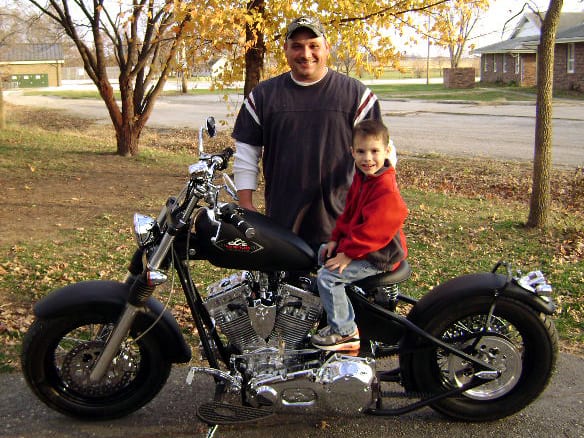
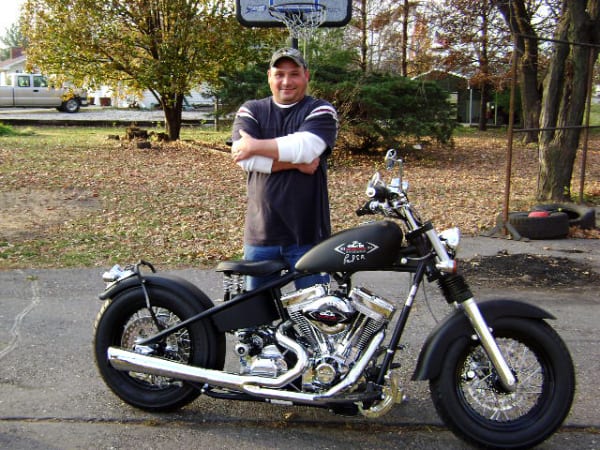
The winner was Bob Pool, machining supervisor at Riverview Manufacturing Inc., located in Palmyra, Missouri and a division of Doyle Equipment Manufacturing Company, across the Mississippi River in Quincy, Illinois. Doyle is a major manufacturer of dry bulk handling machinery and Riverview fabricates large-capacity fertilizer spreaders and other equipment for its parent company.
As Bob tells his story, “I’d gone to IMTS with a colleague from Riverview and we noticed the crowd at the Siemens booth. We were waiting in a very long line to get our picture taken with Paul Teutel from Orange County Choppers and the nice young lady who was registering us asked if we wanted to sign up to win the motorcycle. I’d ridden bikes all my life but never owned one. I figured I’d take the chance, but didn’t think about it much, after signing up. The photographer said the photos would be up at the website a couple days later and, when I checked, I couldn’t find them, so I called Siemens. The next morning, I came into the shop and saw a message from Siemens. I called and asked about the photos and got steered to the right spot on the website, but the person said he was really calling for another reason. To my surprise, he said I’d won the bike!”
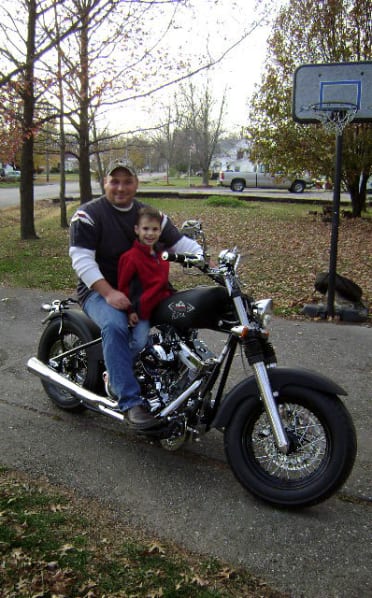
Riverview is a 25-person shop with full CNC machining, welding and assembly capabilities, all used to produce the 6- and 8-ton spreaders and other Doyle brand equipment built here. Bob says he looks forward to taking very good care of his new bike and using it for many years to come. “I’m really enjoying it and am sure glad I stopped by the Siemens booth at IMTS!”
For more information:
SIEMENS INDUSTRY, INC.
DRIVE TECHNOLOGIES
MOTION CONTROL
MACHINE TOOL BUSINESS
390 Kent Avenue
Elk Grove Village, IL 60007
Phone: 847-640-1595
Fax: 847-437-0784
Web: www.usa.siemens.com/cnc
Email: SiemensMTBUMarCom.sea@siemens.com
Attention: John Meyer, Manager, Marketing Communication
Follow us on Facebook: www.facebook.com/SiemensCNC or Twitter: www.twitter.com/siemens_cnc_us.
—
Siemens Industry Sector is the world’s leading supplier of innovative and environmentally friendly products, solutions and services for industrial customers. With end-to-end automation technology and industrial software, solid vertical-market expertise, and technology-based services, the sector enhances its customers’ productivity, efficiency and flexibility. With a global workforce of more than 100,000 employees, the Industry Sector comprises the Industry Automation, Drive Technologies and Customer Services Divisions as well as the Metals Technologies Business Unit. For more information, visit http://www.usa.siemens.com/industry.
The Siemens Drive Technologies Division is the world’s leading supplier of products, systems, applications, solutions and services for the entire drive train, with electrical and mechanical components. Drive Technologies serves all vertical markets in the production and process industries as well as the infrastructure/energy segment. With its products and solutions, the division enables its customers to achieve productivity, energy efficiency and reliability. For more information, visit http://www.usa.siemens.com/drivetechnologies.
Continue readingSinumerik MDynamics Milling Roadshow is coming to IMTS 2010.
If your company is looking for the way to more efficiently cut parts for aerospace, automotive or medical, one thing is certain — the demand for five-axis CNC machining has risen dramatically. And now there’s MDynamics: using one solid CAD/CAM/CNC process chain will get you to market faster than your five-axis competitors who will be lagging under a less integrated approach.
What is Sinumerik MDynamics?
“For users, it is extremely important to get from the blueprint to the finished part quickly, precisely and cost-effectively,” says John Meyer, marketing communications manager, Siemens Industry, Inc. “Sinumerik MDynamics combines our milling expertise together with our powerful Sinumerik CNC hardware platform, intelligent CNC functions, and our unique CAD/CAM/CNC process chain to form integrated technology packages for three- and five-axis milling.”
Seeing is believing.
According to Robert Scholz, international business development manager, Siemens Industry, Inc., Motion Control Business, “Together with leading machine tool OEMs, Siemens will demonstrate how users can benefit from accurate, high-speed machining and perfect workpiece surfaces. Every roadshow event will demonstrate part programming and simulation with NX CAM, followed by five-axis part manufacturing using MDynamics functions and Sinumerik CNC. With real applications for the automotive, aerospace and medical industry, we will prove to our customers that we are the perfect fit for every industry.”
From A-Z and everything in between, Siemens has you covered.
By providing a uniform and integrated system that ranges from programming directly at the CNC for simple parts, to a CAD/CAM system for complex workpieces, Siemens has the right solution for all CNC machining needs. With NX CAM, Siemens provides manufacturing engineers with an open and flexible 3D system that applies not only to the development of part models and drawings, but also to full NC programming and machining simulation. NX enables 3D and 2D construction in a full-, partial- and non-paramaterized form. The fully-integrated NX CAD/CAM system supports a complete part model to CNC program process and even offers 3D quality inspection programming in the same system. NX CAM provides optimized output for Siemens-controlled machines with additional programming commands and automated post-processor functions. During planning and into production, special focus is placed on the process related to the workpiece.
This process chain includes:
Product and process development using advanced CAD/CAM software
Part program generation for the most advanced machine tools
Optimized part program and post-processor output for maximum machining performance
Integrated and offline simulation for checking and optimization of manufacturing process on the PC
Optimized and highly-efficient manufacturing on the machine
See what Sinumerik MDynamics can do for your business!
Attend the Siemens Sinumerik MDynamics Milling Roadshow.
Roadshow schedule
20-minute demonstrations every day
during IMTS, September 13–18, 2010
12:30 p.m. — Milling for Medical
DMG/ Mori Seiki, booth S-8900
1:30 p.m. — Milling for Automotive
Grob Systems, booth S-9066
2:30 p.m. — Milling for Aerospace
MAG, booth S-8519
www.usa.siemens.com/cncroadshow
Continue readingCHICAGO, IMTS — At this year’s International Manufacturing Technology Show (IMTS) in Chicago, Siemens will introduce new solutions and services for machine tool manufacturers and end-users. Under the theme, “Productivity in motion,” the presentation will focus on turnkey solutions for the job shop, aerospace, automotive, mold and die and medical manufacturing industries.
For machine tool builders and end-users, Siemens will exhibit the newest innovations in CNC (computer numerical control), motor and drive technology as well as new value-added services ranging from condition monitoring and manufacturing IT to innovative solutions for CNC training and machine tool retrofit.
SOLUTIONS FOR THE JOB SHOP
For the job shop, the new Sinumerik 828D numerical control will be presented for the first time in the United States. Perfect for mid-range machine tools, the Sinumerik 828D is designed to address the needs of complex milling and turning machines in the job shop segment. It combines CNC, PLC, operator panel and axis control for six CNC measurement circuits in a single, robust operator panel.
The Sinumerik 828D is capable of full graphical, high-level language command and supports ISO programming that is customary in the United States. The new control is ideal for single-part and small-batch production. Programming time can be further reduced for small-batch production with the use of the ShopMill and ShopTurn graphical workstep programming system, while high-level language programming can be used in conjunction with programGuide to significantly reduce programming times for large-scale serial production.
With the introduction of the Sinumerik 828D, modern PC and mobile phone technology is now available to the mid-range machine tool. Extensive online help animations and a new type of input prompting system with moving picture sequences provide the basis for exceptional user convenience. USB, Compact Flash (CF) card and Ethernet ports enable high-speed data transfers onto storage media or integration of the control system into corporate networks. Through the use of its Easy Message functionality, the Sinumerik 828D offers production status monitoring by text messaging (SMS). Depending on the recipient’s profile setting, the machine will transmit information about workpiece machining status, report on the tool condition currently in use and send machine maintenance bulletins to a mobile phone, anytime and anywhere. These combined functions are designed to help keep machine downtime to a minimum.
For the aerospace market, the new Sinumerik 840D solution line is the latest in CNC technology that increases performance and user productivity. The Sinumerik 840D sl is a universal and flexible CNC system featuring the innovative Sinamics S120 drives that can be used for up to 31 axes. It is a distributed, scalable, open and inter-connecting system offering a wide range of specialized functions for milling, drilling, turning, grinding and handling technologies.
The Sinumerik 840D offers users innovative features that increase productivity on the manufacturing floor, especially the challenging segments of high-speed and five-axis aerospace machining.
SOLUTIONS FOR AUTOMOTIVE
In the automotive industry, Siemens continues to solidify its position with the Transline System Solution, the solution for automotive powertrain. This system integrates diverse metalcutting technologies such as milling, drilling, turning and grinding, and the assembly of powertrain parts, under a common system architecture. Since its implementation in 1993 at the Mercedes Benz NVM engine plant in Bad Canstatt, Germany, Transline has grown to become a recognized standard of excellence in the United States among both OEMs and end-users.
Based on the new Sinumerik 840D solution line and Simatic PLC, the Transline solution line transforms the company’s concept of “productivity in motion” into a real world application for total factory automation. By specifying Transline, machine tool users benefit from faster start-up times, better equipment serviceability and increased productivity.
SOLUTIONS FOR MANUFACTURING EXCELLENCE
Condition Monitoring and Manufacturing IT are two value-added services that are continuing their introduction to the U.S. machine tool market.
Condition Monitoring is an internet-based service from Siemens that supports maintenance processes while simultaneously forming a platform for cross-company service and support between OEMs and machine operators. Services can be configured over secure Internet connections from anywhere in the world via a standard PC, an internet connection and a web browser.
Manufacturing IT solutions from Siemens provide software tools for fast, easy integration of machines in a production network, while ensuring that production planning, scheduling and execution is always problem-free and based on the very latest data.
An entire line of powerful software modules for production machines ensures optimum integration of the machines in the IT-environment and supports a wide range of different functionalities including:
SOLUTIONS FOR CNC TRAINING
SinuTrain, the Siemens package of CNC training software on CD-ROM, provides milling and turning machine operators with a high degree of practical hands-on experience, prior to using the CNCs on their actual machines. It is designed to run on Windows XP operating systems and is the optimal solution for machine tool control-identical simulation training.
With SinuTrain, actual NC programs are developed and simulated, using a direct connection to the company’s CAD systems to further speed the program generation protocol. In this way, machine tool operators not only learn the control language commands, but they also visualize part programs on a P
C screen that are identical to the actual machine screen. As a further benefit, programs generated through SinuTrain on the PC software can then be used on the machines.
Other exhibits on display in the Siemens booth include the new 1FK7 high-inertia and 1PH8 servomotors, integrated motor spindles, linear motors and direct-drive torque motors that contribute to the increase in machine performance. The exhibition will also focus on machine tool retrofit, field service, customer service, spare parts and repair, all of which support the machine tool manufacturer and end-user.
For product information and inquiries:
SIEMENS INDUSTRY, INC.
DRIVE TECHNOLOGIES
MOTION CONTROL
MACHINE TOOL BUSINESS
390 Kent Avenue
Elk Grove Village, IL 60007
Phone: 847-640-1595
Fax: 847-437-0784
Web: www.usa.siemens.com/cnc
Email: SiemensMTBUMarCom.sea@siemens.com
Attention: John Meyer, Manager, Marketing Communication
Follow us on Facebook: www.facebook.com/SiemensCNC or Twitter: www.twitter.com/siemens_cnc_us.
—
Siemens Industry Sector is the world’s leading supplier of innovative and environmentally friendly products, solutions and services for industrial customers. With end-to-end automation technology and industrial software, solid vertical-market expertise, and technology-based services, the sector enhances its customers’ productivity, efficiency and flexibility. With a global workforce of more than 100,000 employees, the Industry Sector comprises the Industry Automation, Drive Technologies and Customer Services Divisions as well as the Metals Technologies Business Unit. For more information, visit http://www.usa.siemens.com/industry.
The Siemens Drive Technologies Division is the world’s leading supplier of products, systems, applications, solutions and services for the entire drive train, with electrical and mechanical components. Drive Technologies serves all vertical markets in the production and process industries as well as the infrastructure/energy segment. With its products and solutions, the division enables its customers to achieve productivity, energy efficiency and reliability. For more information, visit http://www.usa.siemens.com/drivetechnologies.
Continue readingBy using a Zimmermann FZ42 portal milling center, Volvo gets the power and torque needed to cut engine fan cases plus the accuracy to turn the machine tool into a coordinate measuring machine for inspection of finished parts
Located near Hartford, Conn., Volvo Aero Connecticut specializes in the machining of large components: fan cases for aircraft engines and gas turbines, fan and compressor structures, compressor rotors, low-pressure turbine cases (LPT) and military parts, usually from aluminum and titanium, as well as Inconel and Waspaloy. It currently manufactures the largest fan casing in the world, at 3.5 meters (11.5 feet) in diameter, for the massive GE90, the only aircraft engine in existence providing 127,900 pounds of thrust, to power the Boeing 777 line. Volvo Aerospace also produces numerous titanium fan cases for Rolls Royce engines.
With the large workpieces, high material removal rates and challenging geometries inherent in aerospace metals manufacturing, coupled with substrates that are often difficult to machine, such as titanium, there is always a need for powerful machining with superior accuracy. Such conditions present substantial hurdles at aerospace supply companies, as they seek to maintain that delicate balance between these seemingly opposing concepts.
As part of its program for the GEnx engine, to be used on the Boeing 787 Dreamliner, Volvo Aero Connecticut recently added a Zimmermann FZ42 machine tool, a five-axis, five-side portal milling center, to its already impressive manufacturing cells at the Hartford facility. The new machine joins other five-axis mills, vertical turning machines, four-axis machining centers and a deburring robot.
Key features on the FZ42 that led Volvo Aero Connecticut to make this acquisition included:
In addition, this FZ42 carries a high accuracy package that provides optimum temperature control of the structural machine parts through the use of a special fiber-reinforced compound in the massive side columns. Also facilitating this process are built-in cooling ducts in the portal and Z-axis slide, independent cooling circuits for the A-axis, C-axis and spindle, ground surfaces on the guideways for the Z-axis and side columns, plus a double-pitch measuring system on the A-axis and C-axis.
During the course of manufacturing, thermal expansion of both machine components and workpieces can substantially impact the positioning accuracy of the machine, the stability of the workpiece and the resulting effect on the finished part dimensions. This unique combination of temperature control and mechanical accuracy in the machine construction were an important deciding factor for Volvo Aerospace in acquiring the FZ42.
According to Martin Thorden, engineering manager at Volvo Aero Connecticut, “These features, combined with the onsite machine set-up provided by Zimmermann, were very important to us, especially on this new GEnx project.” Thorden further noted the importance of the control on the machine, a Sinumerik 840D CNC from Siemens. “We see a very big benefit in how well we are able to control the tool with the CNC. We have been able to use the control to take on additional tasks that were previously handled by our CAD/CAM system.” Specifically, he cited the unconventional approach Volvo Aerospace took in machining the big fan cases. They installed the machine without a rotary table, thus realizing over $500,000 in direct cost savings plus material handling time. As a result of that decision, they believed they needed a top-of-the-line control to probe and accurately machine all the features on the part.
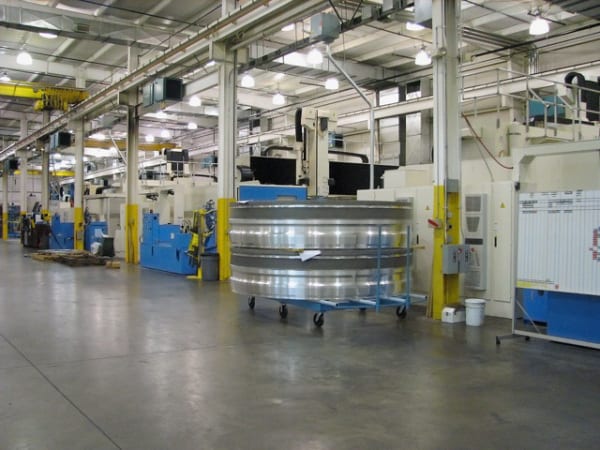
Volvo Aero Connecticut, located near Hartford, comprises three buildings, the largest being 40,000 square feet, where various aerospace and military aircraft components are typically produced from aluminum, titanium, Inconel and Waspaloy.
After machining, Volvo Aero Connecticut can actually transition the machine tool into a coordinate measuring machine for inspection, according to Thorden, owing to the superior accuracy provided by the CNC, as well as the special 90 degree angle heads supplied with the machine, part of the MuST® spindle technology from Zimmermann.
Onboard the machine tool, a massive 120-position tool carriage holds various HSK63 and HSK100 tools that are used to machine the substrates worked here. Inside a series of four side stations, within the machine workspace, four additional specialty tools are stored and used for various operations in the machining and measuring process.
All motors and the drive package onboard the Zimmermann FZ42 at this Volvo Aero Connecticut facility are also made by Siemens.
In a typical machining sequence, the milling head on this machine, equipped with the Zimmermann MuST® spindle system, provides Volvo Aerospace numerous other advantages, according to Martin Thorden. All roughing and subsequent finish passes on any material can be achieved in one set-up, which reduces the preparation time and overall production costs by as much as 10%. There is also no need for additional machines and the corresponding materials handling time. The head design further enables Volvo Aero Connecticut to perform tasks other than milling, using the specialty heads stored on the side stations. Changing the spindle, instead of the milling head, enhances repeatability and further reduces the company’s spindle interface costs, according to Thorden.
The combination of increased accuracies, reduced equipment needs and faster throughput has highlighted this Zimmermann machine installation at Volvo Aero Connecticut.
For additional product information and inquiries:
Zimmermann Inc.
Phone: 248-305-9707
Web: www.zimmermann-inc.com
Email: Matthias@zimmermann-inc.com
Attention: Matthias Tockook
Volvo Aero Connecticut
Phone: 860-667-8502
Web: www.volvoaero.com
Email: Martin.Thorden@volvo.com
Attention: Martin Thorden
Siemens Machine Tool Business
John Meyer
Manager, Marketing Communications
Siemens Industry, Inc.
(847) 640-1595
www.usa.siemens.com/cnc
SiemensMTBUMarCom.industry@siemens.com
Follow us on Facebook: www.facebook.com/SiemensCNC or Twitter: www.twitter.com/siemens_cnc_us.
—
Siemens Industry Sector is the world’s leading supplier of innovative and environmentally friendly products, solutions and services for industrial customers. With end-to-end automation technology and industrial software, solid vertical-market expertise, and technology-based services, the sector enhances its customers’ productivity, efficiency and flexibility. With a global workforce of more than 100,000 employees, the Industry Sector comprises the Industry Automation, Drive Technologies and Customer Services Divisions as well as the Metals Technologies Business Unit. For more information, visit http://www.usa.siemens.com/industry.
The Siemens Drive Technologies Division is the world’s leading supplier of products, systems, applications, solutions and services for the entire drive train, with electrical and mechanical components. Drive Technologies serves all vertical markets in the production and process industries as well as the infrastructure/energy segment. With its products and solutions, the division enables its customers to achieve productivity, energy efficiency and reliability. For more information, visit http://www.usa.siemens.com/drivetechnologies.
Continue reading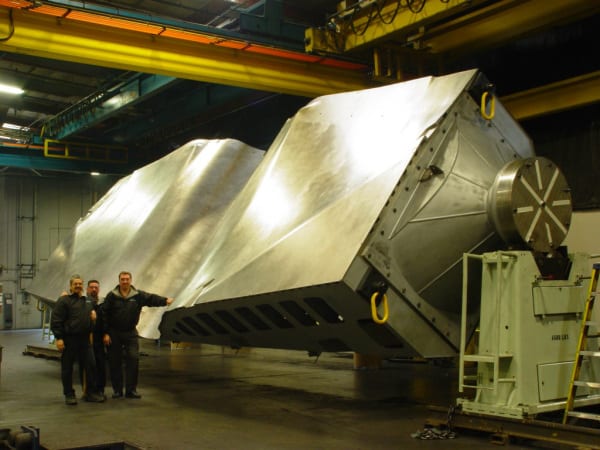
On the largest CNC mill at Coast, a German-built Handtmann five-axis machine that uses twin Siemens Sinumerik 840D numerical controls, the Siemens Volumetric Compensation System (VCS) acts in tandem with a proprietary temperature compensation system devised and implemented by Coast engineers. By combining these technologies with ongoing laser calibration, Coast achieves and maintains accuracies to +/- 0.003” on its longest runs. The Handtmann gantry mill can accommodate structures to 22’ wide x 75’ long x 84” high.
In operation, Siemens VCS factors all the machine kinematics of its various axes of motion, as well as pitch, yaw and roll, to precisely adjust the orientation of the tool tip to the workpiece. Simultaneously, the Coast temperature compensation system, developed over the company’s years in Invar tooling production for composite parts, further adjusts the machine’s accuracy to compensate the expansion of the machine and the workpiece for ambient temperature variations over a 24-hour period. While other companies in the industry typically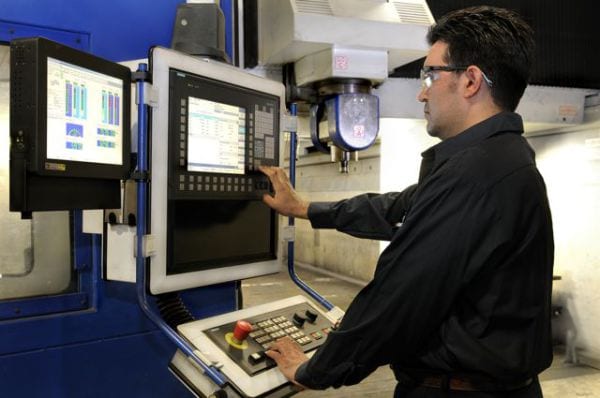
Invar tooling is the industry standard for composite lay-up, owing to its low coefficient of thermal expansion, but, as Coast President Paul Walsh explains, “While the material is a high nickel-iron alloy, which gives it great stability, the bottom line is you still get thermal growth over the long distance runs we process. The system we developed was the result of a lengthy analysis on all our long bed machine tools here.” Coast Composites runs the Handtmann mill at its Irvine facility, as well as Henri Liné five- and six-axis mills, plus SNK and Amura gantry and bridge mills. A 15-year-old Nicolas Correa five-axis gantry mill was recently retrofitted with a new Siemens CNC, motor and drives package, improving both its accuracy and speed, according to Walsh.
Coast Composites founder and current Director of Best Practices, Jerry Anthony, adds, “We knew the Siemens Volumetric Compensation System had substantial merit for our operation when it was first introduced to us, precisely because of the workpiece sizes we run and the corresponding thermal growth during machining, even on Invar tools. We had developed our temperature compensation system to adjust the go-to points from the control for real-time temperature on the machine and the workpiece. The data covered all aspects of our machining, from material composition to acceleration/deceleration mapping and the temperature variations over the largest pieces and longest machine cycles we had performed.” He notes that Coast 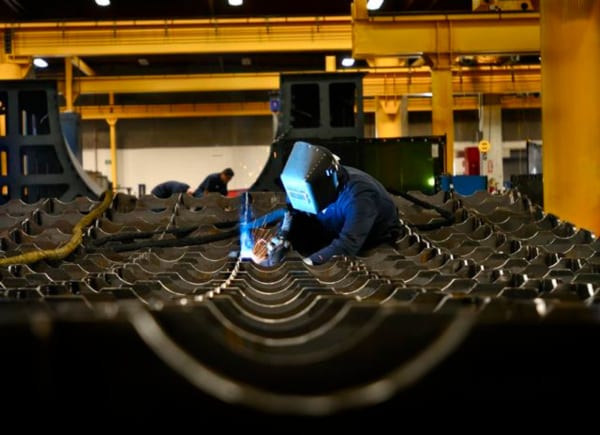
Expanding on the Coast Composites temperature compensation system, Anthony details the on-machine inspection of the workpiece and how the Siemens CNC is actually used to complete this process. “We have used laser tracking in tandem with our Valisys inspection software for some time now, having had a Siemens CNC engineer in Elk Grove Village, Illinois write the machine tool inspection interface software for us. In this way, we were and are now still able to use the power of the CNC to run real-time inspections and data analysis that have been extremely useful as an in-process inspection system for any tool manufactured by Coast.” He muses that the Coast system, “…essentially turns every machine tool here into its own CMM (coordinate measuring machine).” By developing this system at Coast Composites, Jerry Anthony concludes, the laser tracker is now used primarily for final checking, as the in-process monitoring produces what he suggests “…might be the highest accuracy machining standard in the aerospace industry.”
Walsh further comments on the evolution of composites in the commercial sector of the aerospace industry and at Coast. “Composites were only being used in non-critical applications but have now
On the massive Handtmann five-axis gantry mill, application engineering and training assistance were provided to Coast Composites by the machine tool builder’s local representative, Bryan Wilson of BD Technology, as well as personnel from the Siemens Aerospace Center of Competence.
Coast Composites is ISO 9001-2000 registered and AS-9100 Certified and holds numerous customer quality accreditations, including Boeing, Airbus, Northrop Grumman, Lockheed, Kawasaki, GKN and Mitsubishi, among others.
Coast Composites also builds tooling for the construction of such end products as satellite reflectors, used in the telecom and military markets.
HOW THIS MARRIAGE WORKS

In a typical long machining cycle on the very large parts produced at Coast, temperature variations in the workpiece material combine with the naturally occurring thermal expansion in the machine tool to create serious dimensional issues. This is true for whatever material is being run on the machine, even the Invar high nickel-iron alloy used extensively at Coast for producing composite lay-up tooling, fiber tape mandrels and other structures. While Invar has an extremely low coefficient of thermal expansion, the length of the machine cycle invariably (the word from which Invar got its name) results in sufficient thermal movement of the machine, which adversely affects the tool tip position.
In the Siemens VCS, the CNC compensates for 21 error factors of machine axes, pitch, yaw and roll. The true workpiece coordinates, rather than the programmed tool tip position, determine the actual cutting path. In conjunction with the highly advanced Siemens cutter path contouring, this compensation process results in a smoother finish on the part surface and a very high degree of machining accuracy.
In the Coast application, they have further enhanced this process by combining its proprietary temperature compensation system with the VCS inside the CNC to produce a highly accurate cutting path that takes into account the thermal expansion rates for the particular material being run as well as the machine itself.
The standard NC program assumes a 20ºC (68ºF) normal operating condition. This would be the norm for a CMM. The CNC incorporates the Coast temperature compensation system software, while the DNC runs the Valisys software, reading off the Renishaw touch probe data from the workpiece surface. Thus, the temperature compensation is within the machine control, resulting in real-time adjustments to the machine movement and an overall improved surface finish with superior accuracy, according to Anthony. “We have run enough material types and enough cycles to develop an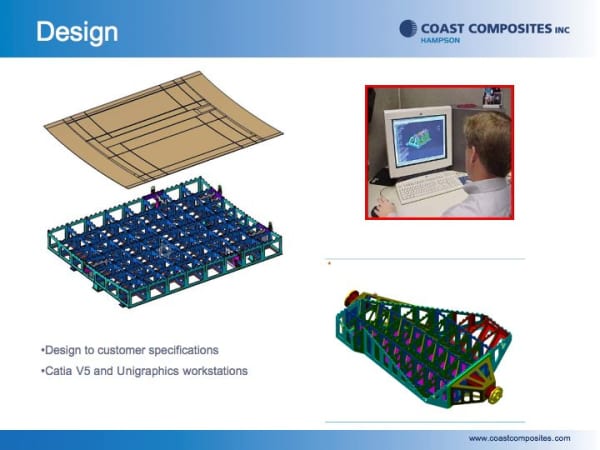
Siemens Aerospace Center of Competence engineers worked closely with the on-staff engineers at Coast Composites to consummate this marriage and, according to Anthony, the results have been beneficial for both parties.
“The relationship between the Siemens Aerospace Center of Competence and Coast Composites began seven years ago and has progressed to a true partnership, as the two companies have worked together consistently, merging advanced theoretical technologies with experiential knowledge. This has been and continues to be a very dynamic synergy between our companies. Siemens is proud to work with such a leader in the aerospace segment,” according to the Siemens account manager for Coast Composites.
For more information, please contact:
Coast Composites Inc. Tooling Division
Web: www.coastcomposites.com
Email: info@coastcomposites.com Attention: Jerry Anthony or Paul Walsh.
Siemens Industry, Inc. Drive Technologies — Motion Control (Machine Tool)
Aerospace Center of Competence Web: www.usa.siemens.com/cnc
Siemens Machine Tool Business
John Meyer
Manager, Marketing Communications
Siemens Industry, Inc.
(847) 640-1595
www.usa.siemens.com/cnc
SiemensMTBUMarCom.industry@siemens.com
Follow us on Facebook: www.facebook.com/SiemensCNC or Twitter: www.twitter.com/siemens_cnc_us.
—
Siemens Industry Sector is the world’s leading supplier of innovative and environmentally friendly products, solutions and services for industrial customers. With end-to-end automation technology and industrial software, solid vertical-market expertise, and technology-based services, the sector enhances its customers’ productivity, efficiency and flexibility. With a global workforce of more than 100,000 employees, the Industry Sector comprises the Industry Automation, Drive Technologies and Customer Services Divisions as well as the Metals Technologies Business Unit. For more information, visit http://www.usa.siemens.com/industry.
The Siemens Drive Technologies Division is the world’s leading supplier of products, systems, applications, solutions and services for the entire drive train, with electrical and mechanical components. Drive Technologies serves all vertical markets in the production and process industries as well as the infrastructure/energy segment. With its products and solutions, the division enables its customers to achieve productivity, energy efficiency and reliability. For more information, visit http://www.usa.siemens.com/drivetechnologies.
Continue reading